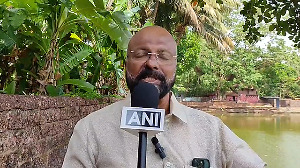The curtain raiser to Budget 2005-06 has been quite something: upto 74 per cent foreign direct investment permitted in telecom, private pension funds given the go-ahead to invest in equities, the National Electricity Policy okayed by the Cabinet.
It is looking like banks too may get to invest 10 per cent of their deposits in stocks. To complete the picture, S&P has upped India's long-term foreign currency rating a notch to just a rung below investment grade.
All in all, not a bad setting for the Budget. The markets are loving the action -- the Sensex is now once again nudging its all time high of 6,651 and, despite the increase in the overnight Fed rate, there seems to be no let-up in buying by FIIs (foreign institutional investors). The pre-Budget rally seems to have begun in earnest.
Tax Reform. That's what everybody seems to be looking for in Palaniappan Chidambaram's next Budget. It's not going to be easy, since revenue collections have been way below targets, but that is unlikely to stop the original reformers from taking some major initiatives on this front.
To begin with, the finance minister should keep up the good work as far as bringing down excise and import tariffs is concerned. He is also reportedly a great believer in the Laffer Curve; so there could be some pleasant surprises in store for taxpayers - both corporate and individual. In short, he may gamble on continued growth in industry and services to bring home the bacon.
Here's a sampling of what you could look forward to:
-
Reworked tax slabs for individuals with benefits accruing to those at the lower end
-
Some exemptions (for example, 80CCC) withdrawn so that the net effect remains the same; exemptions on housing loans should stay
-
Corporate tax rates could be brought down to 30 per cent and depreciation rates, too, could be lowered from the current 25 per cent
-
Service tax rates could be upped from the current 10 per cent and a few more services brought into the net
-
Differential duties could be retained in certain sectors (for instance, textiles)
-
Certain sectors - for example, automobiles, pharmaceuticals, textiles and sugar - could get a boost through changes in excise duties
-
Interest rates on small savings are unlikely to be touched - savers should breathe easy
-
Fertiliser subsidies are likely to go up; food subsidies in all probability will be down
-
Peak custom duties could be brought down from 20 per cent.
It will be hard for the FM to do a repeat of what he did for the capital markets last July - there's little scope for capital gains tax to be reduced further but there's talk that dividend distribution tax could be lowered from the current 12.5 per cent.
On the other hand, reports have it that the securities transaction tax could be raised. The FM has already announced a divestment target of Rs 10,000 crore (Rs 100 billion) in FY06, which means a flood of government paper.
At a macroeconomic level, the FM has a big task on his hands since there is likely to be a serious shortfall in revenues this year.
Besides, there has been no major disbursal from the Rs 40,000 crore (Rs 400 billion) pool for infrastructure. Confederation of Indian Industry has suggested that an Infrastructure Development Board be set up to ensure development of the infrastructure sector.
The hike in FDI for the insurance sector to 49 per cent has not yet happened. Moreover, the trend towards assuring free power has to be reversed urgently and the previous understanding of a minimum power tariff in all states has to be re-established.
Direct taxes
According to the Kelkar Committee, the actual corporate tax rate of over 36 per cent should be brought down and the exemptions for EOUs, EPZs, FTZs done away with.
The committee also wants lower depreciation rates, down from the present 25 per cent, partly in tune with lower corporate rates and partly because of lower inflation. The Shome Committee is also in favour of a lower corporate tax of 30 per cent.
Shome's suggestion
-
Maximum marginal rate of personal income tax should be retained at 30 per cent
-
Remove surcharge
-
Corrections must be made to remove bracket creep from the structure by broadbasing the various brackets
-
Abolish tax incentives under sections 80CCC, 88 and 80L, at least in phases
-
The present corporate tax rate should not exceed the maximum marginal personal income tax. Hence, the corporate tax rate should be reduced to 30 per cent, to bring it in line with the existing level of maximum marginal personal income tax
-
Distribution tax on dividends should be abolished
-
Tax rate for foreign companies should be reduced to the level recommended for domestic companies
The effective corporate tax rate today is around 30 per cent, the rates being higher for capital-intensive companies. Industry would gain from a lower corporate tax but not if depreciation rates are lowered.
According to Ketan Dalal, senior partner, RSM & Co, this might not be the right time to lower depreciation rates since the capex cycle has just begun to turn. EOUs, EPZs and FTZs would be hurt if existing exemptions are prematurely withdrawn, which seems unlikely.
Industry has suggested that existing exemptions be 'grandfathered' and new ones not be added. If exemptions are withdrawn, minimum alternate tax under section 115JB may become irrelevant.
In the context of amalgamations, industry wants two existing conditions -- for holding 75 per cent of the book value of the assets of the amalgamating company for a period of five years, and continuance of the business of the amalgamating company for a minimum period of 5 years by the amalgamated company -- to be dropped. Service companies want a tax break when a loss-making service company merges into a profit-making one.
Personal income tax
The Kelkar Committee had recommended replacing the three slabs with two with the first slab of Rs 100,000-400,000 taxed at 20 per cent, while those in the above Rs 400,000 category being taxed at 30 per cent.
The Shome Committee has recommended that exemptions under section 80L and 88 should be gradually phased out. The maximum tax rate of 30 per cent is likely to stay. However, the FM could ease the burden on marginal taxpayers.
The following is the current personal tax structure:
-
Upto Rs 50,000 - Nil
-
Rs 50,000-60,000 - 10 per cent
-
Rs 60,000-1,50,000 - 20 per cent
-
Above Rs 1,50,000 - 30 per cent
-
Above Rs 850,000 -- 30 per cent plus 10 per cent surcharge. In addition, there is a 2 per cent education cess on all categories.
Indirect taxes
Excise duties: The rate of excise duties for manufactured goods has generally been coming down and for most sectors the rate is 16 per cent though there are special excise duties on some goods.
The Kelkar Committee recommended that the general Cenvat rate should be brought down from 16 per cent to 14 per cent. More recently, a 12 per cent standard rate of excise has been recommended. While rates are more or less uniform, differential rates do exist for sectors such as textiles.
Kelkar's recommendations
-
Eliminate exemptions for corporates as also surcharge
-
Reduce corporate tax from 35 per cent to 30 per cent
-
Cut depreciation rate from 25 per cent to 15 per cent
-
Increase the tax base for services, also align service tax rate with excise duty
-
Remove dividend tax
-
Take away or reduce housing tax sops
-
Scrap exemptions under Section 88 and 80L
-
Raise the threshold for income tax
Customs duties: The peak rate of 40 per cent in 1999 has been gradually brought down to 20 per cent in 2004-05. There is a good chance that duties will be further reduced from 20 per cent to 15 per cent. The Kelkar Committee has suggested that customs duty rates be brought down to 5 per cent, 8 per cent and 10 per cent.
Some products continue to attract higher duties ranging between 30 per cent to 150 per cent -- for instance, agricultural products, alcoholic beverages, automobiles for personal use, cigarettes, aerated soft drinks, sugar, edible oils and processed foods.
There are also products that attract a low duty of 5 per cent -- for example, capital goods for specified purposes, newsprint, non-alloy steel, steam-coal and metallurgical coke.
In a bid to keep in check prices of some key commodities, customs duty rates on certain products were reduced after the Budget 2004-05. These are iron and steel, motor spirit, HSD, LPG, polymers and various petrochemicals.
What Indian industry would like
Automobile
-
Withdrawal of special excise duty on motor cars and multi-utility vehicles
-
Withdrawal of customs duty on CKD, CBU
-
Cut in basic custom duty on HR/CR steel sheets
-
Unchanged excise duty across vehicle categories
-
Withdrawal of special excise duty of 8 per cent on tyres and tubes
Steel and other metals
-
Reduction in import duty on graphite electrodes above 24" from 15 per cent to 10 per cent
-
Cut in import duty on furnace oil to 10 per cent and on limestone to 5 per cent
-
Cut in excise duties on steel
-
Continuance of the duty entitlement passbook scheme
-
Cut in customs duty on coking coal with ash content of 12 per cent or more from 15 per cent to 10 per cent
-
Reduction in customs duty on copper from 15 per cent to 10 per cent
-
Waiver in excise duty on ferro alloys slag
Consumer goods
-
Reduction in excise duty from 16 per cent to 8 per cent on black and white TVs, chassis and picture tubes and electric fans
-
Cut in customs duty on fixed-wireless phones from 10 per cent to 5 per cent
-
Withdrawal of special excise duty on air-conditioners
Capital Goods
-
Revision of customs duty on fertiliser, coal mining and power generation projects from 5 per cent in view of removal of 4 per cent SAD on imports and applicability of sales tax on indigenous goods
Textiles
-
Changes in DEPB scheme to make it WTO compatible
- Refund of 4 per cent of export value in case of cotton made-up and 3 per cent in case of cotton yarn to enable credit for duties paid on raw-materials and semi-finished goods
Oil and petrochemicals
-
Reduction in customs duty on crude petroleum and naphta from 10 per cent to 5 per cent
-
Reduction in excise duties on man-made filament fibres and yarn other than PFY from 16 per cent to 8 per cent
-
Reduction in asic custom duties on synthetic fibre intermediates (PTA, MEG, DMT, caprolactom) to 10 per cent
-
Cut in duties on fibres (POY, PFY, NFY and PSF) to 15 per cent from 20 per cent
-
Cut in duties on butane, octane and heptane to 10 per cent from 15 per cent
Technology
-
Hike in depreciation on computer hardware from 60 per cent to 100 per cent
-
Lowering or abolition of customs duty on computer and peripherals
- Extension of tax exemption for e-commerce and software developers
|
Research calls
ITC (outperformer): Considering the recent ordinance on excise definition of prices of cigarettes, SSKI hopes to see a 'fair' end to the legal issues involving excise definition soon. It expects the stock to remain flat in the near term.
Jain Irrigation (outperformer): SSKI sees upsides in the scrip from valuations of 8x FY06 earnings estimate as the company's business model is likely to help it capitalise on opportunities in the agri sector.
Dabur India (outperformer): Dabur quotes at 15.9x FY06 earnings estimate. After acquiring Balsara and posting impressive Q3FY05 numbers, the company can now look forward to geographical expansion and its leadership in the existing categories for growth, feels SSKI.
Ashok Leyland (buy): ASK Raymond James maintains its buy rating on Ashok Leyland with a target price of Rs 26. At a P/E of 10x for FY06, the downside is limited. The brokerage cites positives like increasing volumes, better product mix , e-sourcing and value engineering.
HCL Technologies (downgrade): ASK RJ has reduced HCLT's EPS estimates for FY05 and FY06 by 12 per cent and 13.2 per cent respectively due to a weaker growth outlook and lower treasury income. It has reduced its price target to Rs 355 in 12 months.
Sun Pharma (outperformer): Prabhudas Lillader feels that the company is in a transformation phase, and expects its initiatives in the US markets to fructify soon. At a price-earnings ration of 20.2x FY05E and 15.1x FY06E, it feels that Sun is trading at attractive valuations in view of the strong growth prospects ahead.
Gujarat State Fertilizers & Chemicals (outperformer): Considering GSFC's strong financial performance, Prabhudas feels that growth will be aided by higher prices for the chemicals business, increased usage of natural gas and higher capacity utilisation. It feels that the stock trades at inexpensive valuations of a price-earnings ratio of 4.8x for FY06E.
Oriental Bank of Commerce (market underperformer): Refco has downgraded OBC to market underperformer with a target price of Rs 290 after which it will trade at 8.4x FY06 earnings. OBC has accumulated losses of Rs 1225 crore, which would reduce its net worth. Refco feels that OBC trades at rich valuations. However, it expects positive surprises like reduction of OBC's net NPAs and possible income tax benefits.
Bharti Shipyard (buy): Prabhudas initiated coverage on Bharati Shipyard with a buy rating. It feels that BSL is experiencing strong growth in the offshore vessel- and anchor-handling-tug segments as high oil prices have made offshore drilling more viable. BSL also has a strong order-book which is constrained only by its installed capacity. Prabhudas feels that the stock is attractively valued at 11.1x FY2005 and 8.0x FY06E earnings and has set a price target of Rs.235. |







 © 2025
© 2025